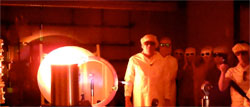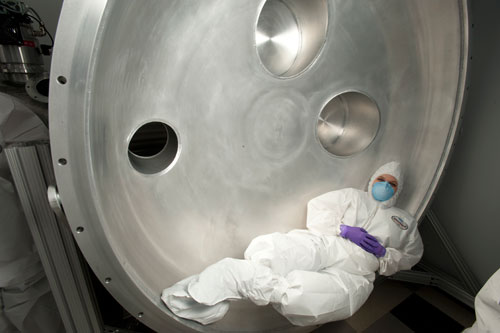Scarlet Laser Achieves First Light:
Greater that 10 Joules in less than 100 femtoseconds.
Five years ago we obtained funding from the Department of Energy National Nuclear Security Administration and the State of Ohio to build a powerful laser system; a laser that could generate some of the most intense laser pulses available in the country and one that could collect data at a high-repetition rate. Today we are proud to demonstrate the results of this effort.
Following a short presentation by Professor Douglass Schumacher, Associate Director of the SCARLET Laser Facility, we demonstrated First Light:
SCARLET generates laser pulses with a peak power over 400 trillion watts. The peak power generated by the U.S. electrical grid is “only” about 1 trillion watts. Our laser pulse only lasts a short time, but for that time it outshines just about everything else. We accomplish this by taking a small amount of energy and delivering it amazingly quickly. Each laser pulse has about 10 Joules of energy. That’s about the heat energy you generate when you rub your hands together.
The key to SCARLET is that it delivers this energy in 25 millionths of a billionth of a second. That’s a mouthful and we just say, 25 fs. It’s hard to explain just how short a time this is. Nothing is faster than light, right? Well, in 25 fs, light can only travel about a third of a hair’s breadth. In 25 fs, all of what you see is motionless.
When matter is subjected to SCARLET level intensities, it behaves completely different to what you’re used to. Using this laser we can generate anti-matter clouds of positrons. We can generate beams of protons that might provide new treatments for certain cancers. We have a program to generate neutrons beams that could help detect dangerous materials being smuggled across our national borders. We have another program that will excite extreme states of matter that could help us learn about planetary and stellar interiors. And finally, we can study the generation of beams of electrons that might be useful for driving fusion reactions for electrical power.
 Dr. Enam Chowdhury is our Chief Laser Scientist, Rebecca Daskalova is our Laser Scientist and Safety Officer, and John Marketon is Senior Engineer. Enam designed this laser. There is no quick way to fairly describe the calculations, simulations, and research and development that were required to build this system. Hundreds of person-hours of design had to go into this system before it could be built. Also, all of the big components you’ll see are custom designed, some taking additional hundreds of hours to design and assemble. How did Enam, Becky, and John get all this done? They had help. Under their direction, a large team of roughly six graduate and fourteen undergraduate students built this laser, and that’s the final message I’d like to leave you with. This is first light. But before the first experiment is even performed, this laser has already served as a teaching platform giving OSU students a one-of-a-kind experience in cutting edge design and construction. For example, John has taught and led a team of over 10 engineering undergraduates who have, over several years, designed the mechanical and software infrastructure this facility depends on, including one-of-a-kind massive mirror mounts and a sophisticated control and safety system.
Dr. Enam Chowdhury is our Chief Laser Scientist, Rebecca Daskalova is our Laser Scientist and Safety Officer, and John Marketon is Senior Engineer. Enam designed this laser. There is no quick way to fairly describe the calculations, simulations, and research and development that were required to build this system. Hundreds of person-hours of design had to go into this system before it could be built. Also, all of the big components you’ll see are custom designed, some taking additional hundreds of hours to design and assemble. How did Enam, Becky, and John get all this done? They had help. Under their direction, a large team of roughly six graduate and fourteen undergraduate students built this laser, and that’s the final message I’d like to leave you with. This is first light. But before the first experiment is even performed, this laser has already served as a teaching platform giving OSU students a one-of-a-kind experience in cutting edge design and construction. For example, John has taught and led a team of over 10 engineering undergraduates who have, over several years, designed the mechanical and software infrastructure this facility depends on, including one-of-a-kind massive mirror mounts and a sophisticated control and safety system.

There has been a significant amount of activity in our lab and a massive effort put forth by the faculty, staff and students to bring us to this momentous occasion. Here you can browse through some of what transpired in just the past few months.
